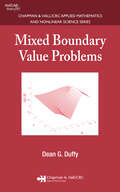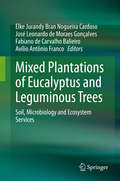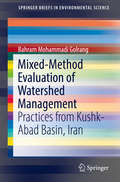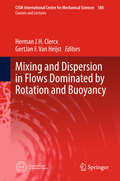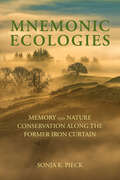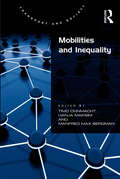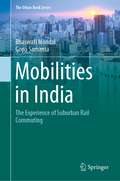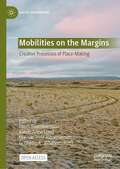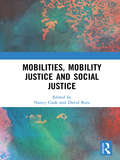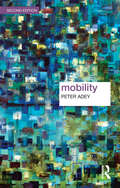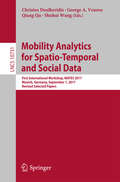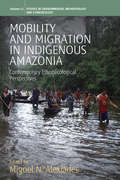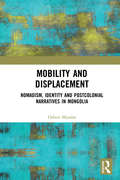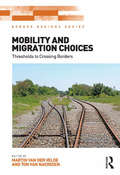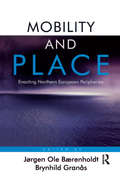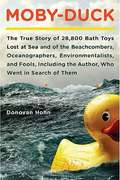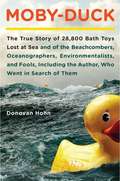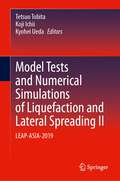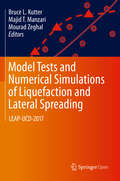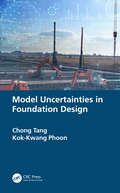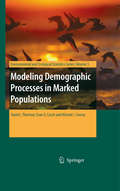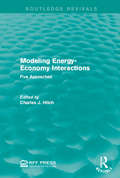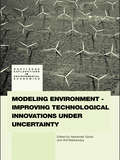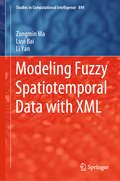- Table View
- List View
Mixed Boundary Value Problems
by Dean G. DuffyMethods for Solving Mixed Boundary Value ProblemsAn up-to-date treatment of the subject, Mixed Boundary Value Problems focuses on boundary value problems when the boundary condition changes along a particular boundary. The book often employs numerical methods to solve mixed boundary value problems and the associated integral equat
Mixed Plantations of Eucalyptus and Leguminous Trees: Soil, Microbiology and Ecosystem Services
by Elke Jurandy Bran Nogueira Cardoso José Leonardo de Moraes Gonçalves Fabiano de Carvalho Balieiro Avílio Antônio FrancoThe aim of this book is to present, in depth, updated information on soil and microbial processes involved in mixed plantations of Eucalyptus and N2-fixing species, especially Acacia mangium, focusing on Forestry, Soils, Biology, Ecosystem Services and Sustainability. The potential of substituting chemical N fertilizer by a consortium of leguminous species that fix atmospheric nitrogen is an interesting solution for a more sustainable, economically and environmentally sound forest system. Among the main topics, we present reference topics on soil microbiology, as biological nitrogen fixation, the role of mycorrhiza in mixed plantations, bio-indicators of soil quality, and plantgrowth promoting bacteria with biotechnological potential. Here we discuss Ecosystem services and ecological benefits of these systems, the invasive potential of A.mangium, as well as the regulations and perspectives of land use policies for mixed forests and their role in the sustainability of the system.
Mixed-Method Evaluation of Watershed Management
by Bahram Mohammadi GolrangThis volume evaluates technical and social aspects of a watershed management program in the Kush-Abad Watershed Basin in Iran. Author Bahram Mohammadi Golrang offers a way forward for a more integrated means to evaluate large scale rural environmental management projects, their effects on the physical environment, how to engage the public in such projects, and how nearby communities interact with them and perceive their effects. The analysis presented here focuses on land treatment efforts initiated by the Watershed Management Organization of Iran, and evaluation spans the project-planning stage through the project's implementation to citizens' perceptions of the project after it was completed. Project planners - especially those in developing countries - will find the lessons in this case study very useful in planning technically sound projects that achieve participation and satisfaction from local populations.
Mixing and Dispersion in Flows Dominated by Rotation and Buoyancy (CISM International Centre for Mechanical Sciences #580)
by Herman J. H. Clercx GertJan F. Van HeijstThe book presents a state-of-the-art overview of current developments in the field in a way accessible to attendees coming from a variety of fields. Relevant examples are turbulence research, (environmental) fluid mechanics, lake hydrodynamics and atmospheric physics. Topics discussed range from the fundamentals of rotating and stratified flows, mixing and transport in stratified or rotating turbulence, transport in the atmospheric boundary layer, the dynamics of gravity and turbidity currents eventually with effects of background rotation or stratification, mixing in (stratified) lakes, and the Lagrangian approach in the analysis of transport processes in geophysical and environmental flows. The topics are discussed from fundamental, experimental and numerical points of view. Some contributions cover fundamental aspects including a number of the basic dynamical properties of rotating and or stratified (turbulent) flows, the mathematical description of these flows, some applications in the natural environment, and the Lagrangian statistical analysis of turbulent transport processes and turbulent transport of material particles (including, for example, inertial and finite-size effects). Four papers are dedicated to specific topics such as transport in (stratified) lakes, transport and mixing in the atmospheric boundary layer, mixing in stratified fluids and dynamics of turbidity currents. The book is addressed to doctoral students and postdoctoral researchers, but also to academic and industrial researchers and practicing engineers, with a background in mechanical engineering, applied physics, civil engineering, applied mathematics, meteorology, physical oceanography or physical limnology.
Mnemonic Ecologies: Memory and Nature Conservation along the Former Iron Curtain
by Sonja K. PieckAn exploration of the Green Belt conservation project between the former East and West Germanies and its relationship to emergent ecosystems, trauma, and memorialization.The first book-length scholarly treatment of Germany&’s largest conservation project, the Green Belt, Mnemonic Ecologies by Sonja Pieck presents a new interdisciplinary approach: that effective restoration and conservation of wounded land must merge ecology with memory. Since the Cold War&’s end in 1989, German conservationists have transformed the once-militarized border between East and West Germany into an extensive protected area. Yet as forests, meadows, and wetlands replace fences, minefields, and guard towers, ecological recovery must reckon with the pain of the borderlands&’ brutal past. The lessons gained by conservationists here, Pieck argues, have profound practical and ethical implications far beyond Germany.Can conservation help heal both ecological and societal wounds? How might conservation honor difficult socioecological pasts? Deeply researched and evocatively written, this beautiful, interdisciplinary investigation into the legacy of war and nature&’s resurgence blends environmental history, ethics, geography, and politics with ecology and memory studies. Amid our rampant biodiversity crisis, Mnemonic Ecologies shows why conservation must include humanized landscapes in its purview, thus helping to craft a new conservation ethos that is collaborative, empathetic, and more sensitive to the connections between humans and the places they inhabit.
Mobilising Design (Routledge Studies in Human Geography)
by Justin Spinney, Suzanne Reimer and Philip PinchThis book brings together research working at the boundary between design knowledges and mobilities, offering a novel collection for both theorists and practitioners. Drawing upon detailed case studies, it demonstrates the diverse roles of design in shaping mobility at different spaces and scales: across cities; within different types of buildings and infrastructures; and through commuting, work and leisure activities. A range of international scholars illustrate the designed mobilities of car parks, traffic lights, street benches, pedestrian wayfinding systems and accessible design in the urban environment; they examine spaces within hospitals, airports and train stations and investigate design practices for bicycles, future urban vehicles and MotoGP motorcycle racing. Other contributions explore overlooked mobile artefacts such as television and video game remote controls, 3D printing and the types of packaging which enable objects themselves to move around. This book demonstrates how the tools, assumptions and processes of design shape spaces of mobility, and also illuminates how shifts in the fluidity and circulation of people, practices and materials in turn reconfigure practices of design. Mobilising Design develops multi-disciplinary understandings of design, drawing upon diverse literatures including design history, product design, architecture and cultural geography. By highlighting often invisible artefacts and associated knowledges and controversies, the book foregrounds the taken-for-granted ways in which everyday mobility is designed. It will be of interest to scholars in geography, sociology, economic history, architecture, design and urban theory.
Mobilities and Inequality (Transport And Society Ser.)
by Manfred Max Bergman Hanja MaksimThis book opens up the debate on the interrelations between space and mobilities with regard to different dimensions of social inequality. Based on the premise that the dynamics caused by modernization, globalization, migration and social change affect the structuring of the social fabric, the focus of the book is to illuminate these processes of social and spatial re-structurings. A leading team of contributors from the Cosmobilities network highlight different aspects of inequality in relation to mobilities, such as gender, supplying transport infrastructure, job-related relocations, multi-locality, social network geography, and socio-spatial development.
Mobilities in India: The Experience of Suburban Rail Commuting (The Urban Book Series)
by Gopa Samanta Bhaswati MondalThis book presents commuting as a new paradigm in mobility studies in the context of global south. It delves into suburban train commuting in Eastern India. The book interprets commuting not only as a means to attend work but also as a process producing kinetic event-space infused with different mobile practices, which is not determined by their locational fixity, rather can be cognized. It analyses the role of suburban train commuting in the metropolitan expansion of Kolkata, and the transformation of rural space into urban. The significant contribution of the book lies in explaining commuters’ experiencescape and the production of spatial fluidity in time capsule through commuting. It also explores the subjective reality of gendered commuting. The book uses a trans-disciplinary research design, blending quantitative and ethnographic research methods. The area selected for the empirical research is the Howrah-Bardhaman Main Railway Line (108 km), the first suburban railway line in Eastern India. Commuters originating from three adjacent districts of Purba Bardhaman, Hooghly and Howrah took part in this research. Besides the commuters, non-commuting passengers and hawkers in the train were also interviewed to understand the diverse perceptions of the process of commuting. This book may be considered as a reference book for mobility studies, transport studies, urban geography and regional planning.
Mobilities on the Margins: Creative Processes of Place-Making (Arctic Encounters)
by Katrín Anna Lund Gunnar Thór Jóhannesson Björn Thorsteinsson Guðbjörg R. JóhannesdóttirThis open access book examines places on the margins and the dynamics through which a marginal position of a place is created. Specifically, it explores how places, mostly in sparsely populated areas, often perceived as immobile and frozen in time, come into being and develop through interference of everyday mobilities and creative practices that cut across the spheres of culture and nature as usually defined. Through fieldwork and case studies from areas in Iceland, Finland, Greenland, and Scotland, the book’s twelve chapters draw out the multiple relations through which places emerge, where people compose their lives as best they can with their surroundings. A special concern is to explore the links between travelling, landscape, and material culture and how places and margins are enacted through mobilities and creative practices of humans and other beings. The emphasis on mobility disturbs the perception of a place as a bounded entity and offers a useful and necessary understanding of places as mobile and fluid. Mobilities on the Margins is a novel and timely contribution to the exploration of human and more-than-human interactions in a world of increasingly fluid mobilities and insistent crises.
Mobilities, Mobility Justice and Social Justice
by Nancy Cook David ButzThis book offers a cutting-edge overview of mobility, mobility justice and social justice, with contributions from a broad range of leading scholars. Mobility justice is understood as a way to frame the entanglements of power and social exclusion in the mobilities of humans, things, and ideas, as well as to differential and unequal access to movement, and the ability to move. The introductory chapters firmly ground the concept of mobility justice and social justice, with the proceeding chapters covering a range of topics from race, sexuality, ferry justice and aeromobility justice, animal mobilities, design, and food mobilities.
Mobility (Key Ideas in Geography)
by Peter AdeyMobility aims to take the pulse of this enormously expanded and energetic field. It explores the breadth of the disciplinary areas mobility studies now encompass, examining the diverse conceptual and methodological approaches wielded within the field, and explores the utility of mobility to illuminate a cornucopia of mobile lives: from the mass movements of individuals within global processes such as migration and tourism, to homelessness and war; from the entangled relations caught up in the movement of disease, people and aid across borders, to the inability of someone to cross over a road. The new edition explores the more sustained elaboration of mobility studies within a wide variety of disciplinary approaches and subject matters. It echoes the growing internationalization of mobility research, reflected in diverse case studies from the Global South, South Asia, Latin America, the Caribbean and so far under-represented perspectives from China, Australasia, post-socialist Eastern Europe, the Middle East and elsewhere. The book also features an additional chapter on mobility studies, to survey and explore the diverse quality of the field, and methodologies, in order to reflect the growing diversity of methodological approaches to mobilities, from walk-alongs and critical cartography to the mobile arts. The book offers an accessible reading of the way mobility has been tackled and understood, neatly exploring and summarizing a topic that has exploded into different variations and nuances. The text allows scholars and students alike to grasp the central importance of ‘mobility’ to social, cultural, political, economic and everyday terrains by providing accessible writings on key authors within key ideas and case study boxes, suggested further readings and summaries, while at the same time making a significant contribution to scholarly writings and debates.
Mobility Analytics for Spatio-Temporal and Social Data: First International Workshop, MATES 2017, Munich, Germany, September 1, 2017, Revised Selected Papers (Lecture Notes in Computer Science #10731)
by Christos Doulkeridis George A. Vouros Qiang Qu Shuhui WangThis book constitutes the refereed post-conference proceedings of the First International Workshop on Mobility Analytics for Spatio-Temporal and Social Data, MATES 2017, held in Munich, Germany, in September 2017. The 6 revised full papers and 2 short papers included in this volume were carefully reviewed and selected from 13 submissions. Also included are two keynote speeches. The papers intend to raise awareness of real-world problems in critical domains which require novel data management solutions. They are organized in two thematic sections: social network analytics and applications, and spatio-temporal mobility analytics.
Mobility And Migration In Indigenous Amazonia
by Miguel N. AlexiadesContrary to ingrained academic and public assumptions, wherein indigenous lowland South American societies are viewed as the product of historical emplacement and spatial stasis, there is widespread evidence to suggest that migration and displacement have been the norm, and not the exception. This original and thought-provoking collection of case studies examines some of the ways in which migration, and the concomitant processes of ecological and social change, have shaped and continue to shape human-environment relations in Amazonia. Drawing on a wide range of historical time frames (from pre-conquest times to the present) and ethnographic contexts, different chapters examine the complex and important links between migration and the classification, management, and domestication of plants and landscapes, as well as the incorporation and transformation of environmental knowledge, practices, ideologies and identities.
Mobility and Displacement: Nomadism, Identity and Postcolonial Narratives in Mongolia
by Orhon MyadarThis book explores and contests both outsiders’ projections of Mongolia and the self-objectifying tropes Mongolians routinely deploy to represent their own country as a land of nomads.It speaks to the experiences of many societies and cultures that are routinely treated as exotic, romantic, primitive or otherwise different and Other in Euro-American imaginaries, and how these imaginaries are also internally produced by those societies themselves. The assumption that Mongolia is a nomadic nation is largely predicated upon Mongolia’s environmental and climatic conditions, which are understood to make Mongolia suitable for little else than pastoral nomadism. But to the contrary, the majority of Mongolians have been settled in and around cities and small population centers. Even Mongolians who are herders have long been unable to move freely in a smooth space, as dictated by the needs of their herds, and as they would as free-roaming "nomads." Instead, they have been subjected to various constraints across time that have significantly limited their movement. The book weaves threads from disparate branches of Mongolian studies to expose various visible and invisible constraints on population mobility in Mongolia from the Qing period to the post-socialist era. With its in-depth analysis of the complexities of the relationship between land rights, mobility, displacement, and the state, the book makes a valuable contribution to the fields of cultural geography, political geography, heritage and culture studies, as well as Eurasian and Inner-Asian Studies.
Mobility and Migration Choices: Thresholds to Crossing Borders (Border Regions Series)
by Ton van Naerssen Martin van VeldeThe crossing of national state borders is one of the most-discussed issues of contemporary times and it poses many challenges for individual and collective identities. This concerns both short-distance mobility as well as long-distance migration. Choosing to move - or not - across international borders is a complex decision, involving both cognitive and emotional processes. This book tests the approach that three crucial thresholds need to be crossed before mobility occurs; the individual’s mindset about migrating, the choice of destination and perception of crossing borders to that location and the specific routes and spatial trajectories available to get there. Thus both borders and trajectories can act as thresholds to spatial moves. The threshold approach, with its focus on processes affecting whether, when and where to move, aims to understand the decision-making process in all its dimensions, in the hope that this will lead to a better understanding of the ways migrants conceive, perceive and undertake their transnational journeys. This book examines the three constitutive parts discerned in the cross-border mobility decision-making process: people, borders and trajectories and their interrelationships. Illustrated by a global range of case studies, it demonstrates that the relation between the three is not fixed but flexible and that decision-making contains aspects of belonging, instability, security and volatility affecting their mobility or immobility.
Mobility and Place: Enacting Northern European Peripheries
by Brynhild Granås Jørgen Ole BærenholdtThe Northern peripheries of Europe, which are covered by this book, are associated with remoteness, the frontier, isolated communities, colonialism and resource extraction. Recently, huge projects in petroleum and hydropower have been located there, and the region has become better known as an attractive tourist destination. Although these spaces are perceived as being marginal, they are inhabited and linked into globalization and international agendas. This book examines how people live in such remote spaces in an emerging global world of connectivity, interdependency, mobility and non-linear dynamics. The various case studies examine a wide range of experiences, ranging from tourists and local settlers to those who migrate for labour in old or new industries, or to pursue the hybrid urban/rural life of the periphery. In this book, mobility and place come together. The analyses demonstrate how mobility and place mutually constitute each other and how specific relationships between the two aspects are crucial in the making of societies. The authors study attempts to reinvent places, together with connections and the opening of 'new scapes' in order to sustain businesses, municipalities and people's livelihood.
Moby-Duck
by Donovan HohnWhen Donovan Hohn first heard the remarkable story of how 28,904 bath toys spilled into the Pacific en route to the US from China and have been washing up along beaches throughout the world ever since, he decided to find out more and assumed he would interview a few oceanographers, talk to some beachcombers and read up on Arctic science and geography. ‘But questions can be like ocean currents: wade in too far, and they carry you away. ’ Setting out on a series of journeys to track the renegade rubber ducks, Moby-Duck is an adventure into the heart of the sea through science, myth, the global economy and some of the worst weather imaginable, and the riveting story of an accidental odyssey which pulled Hohn into the secretive world of shipping conglomerates, the daring terrain of Arctic researchers, the lunatic risks of maverick sailors, and the shadowy domain of Chinese toy factories. With each new discovery, Hohn learns of another loose thread, and with each successive chase he comes closer to understanding where his castaway quarry comes from (and where it is heading…). In the grand tradition of Tony Horwitz and David Quammen, Moby-Duck is a compulsively readable narrative of whimsy and curiosity for anyone who is interested in obsession, travel, plastic, and that great American novel, Moby-Dick.
Moby-Duck: The True Story of 28,800 Bath Toys Lost at Sea and of the Beachcombers, Oceanographers, Environmentalists, and Fools, Including the Author, Who Went in Search of Them
by Donovan HohnA revelatory tale of science, adventure, and modern myth, "Moby-Duck" is the true story of 28,800 bath toys lost at sea, and of the people who went after them.
Model Tests and Numerical Simulations of Liquefaction and Lateral Spreading II: LEAP-ASIA-2019
by Tetsuo Tobita Koji Ichii Kyohei UedaThis open access book presents work collected through the Liquefaction Experiments and Analysis Projects (LEAP) in 2019 (LEAP-ASIA-2019) following the LEAP-UCD-2017 whose results have been published as a first volume. In addition to the research targets set in the previous one, such as the repeatability, variability, and sensitivity of lateral spreading on mildly sloping liquefiable sand, this volume includes research efforts to validate the generalized scaling law (hereafter “GSL”) for the identical prototype with the one employed in UCD-2017. In LEAP-ASIA-2019, 10 institutes around the world conducted 23 tests in total. It was the first multi-institutional attempts to investigate the validity of the generalized scaling law for the saturated sandy sloping deposit with wide range of initial conditions. The experimental data provided a unique basis for assessing the capabilities of six different simulation platforms for numerical simulation of soil liquefaction. The results of the experiments and the numerical simulations are presented and discussed in papers submitted by the project participants.
Model Tests and Numerical Simulations of Liquefaction and Lateral Spreading: LEAP-UCD-2017
by Bruce L. Kutter Majid T. Manzari Mourad ZeghalThis open access book presents work collected through the Liquefaction Experiments and Analysis Projects (LEAP) in 2017. It addresses the repeatability, variability, and sensitivity of lateral spreading observed in twenty-four centrifuge model tests on mildly sloping liquefiable sand. The centrifuge tests were conducted at nine different centrifuge facilities around the world. For the first time, a sufficient number of experiments were conducted to enable assessment of variability of centrifuge test results. The experimental data provided a unique basis for assessing the capabilities of twelve different simulation platforms for numerical simulation of soil liquefaction. The results of the experiments and the numerical simulations are presented and discussed in papers submitted by the project participants. The work presented in this book was followed by LEAP-Asia that included assessment of a generalized scaling law and culminated in a workshop in Osaka, Japan in March 2019. LEAP-2020, ongoing at the time of printing, is addressing the validation of soil-structure interaction analyses of retaining walls involving a liquefiable soil. A workshop is planned at RPI, USA in 2020.
Model Uncertainties in Foundation Design
by Kok-Kwang Phoon Chong TangModel Uncertainties in Foundation Design is unique in the compilation of the largest and the most diverse load test databases to date, covering many foundation types (shallow foundations, spudcans, driven piles, drilled shafts, rock sockets and helical piles) and a wide range of ground conditions (soil to soft rock). All databases with names prefixed by NUS are available upon request. This book presents a comprehensive evaluation of the model factor mean (bias) and coefficient of variation (COV) for ultimate and serviceability limit state based on these databases. These statistics can be used directly for AASHTO LRFD calibration. Besides load test databases, performance databases for other geo-structures and their model factor statistics are provided. Based on this extensive literature survey, a practical three-tier scheme for classifying the model uncertainty of geo-structures according to the model factor mean and COV is proposed. This empirically grounded scheme can underpin the calibration of resistance factors as a function of the degree of understanding – a concept already adopted in the Canadian Highway Bridge Design Code and being considered for the new draft for Eurocode 7 Part 1 (EN 1997-1:202x). The helical pile research in Chapter 7 was recognised by the 2020 ASCE Norman Medal.
Modeling Demographic Processes in Marked Populations
by David L. Thomson Michael J. Conroy Evan G. CoochThis book brings together biologists and statisticians in an interdisciplinary synthesis to develop new methods to overcome the most significant challenges and constraints faced by quantitative biologists seeking to model demographic rates. The book is centered on the ten key areas in the field where important problems in demographic analysis are being solved with new statistical methods. Each area presents one overview written by an acknowledged expert in this field, and four original research contributions. The 10 key areas are: - Abundance estimation; direct, proxies and point counts; Population dynamics; - Combining sources of information; - Dispersal movement and migration; - State uncertainty: assignment error and unobservable states; - Robust design: sampling, applications and advances; - Bayesian applications: advances, random effects and hierarchical models; - Evolutionary ecology; - Wildlife and conservation management; - Software developments for the modelling of demographic rates in marked populations.
Modeling Energy-Economy Interactions: Five Appoaches (Routledge Revivals)
by Charles J. HitchThis report, first published in 1977, explores several different approaches to the same question; namely, how severe will be the impact on key U.S. macro-economic variables of the transition from main reliance on oil and natural gas to other sources of energy? This book will be of interest to students of economics and environmental studies.
Modeling Environment-Improving Technological Innovations under Uncertainty (Routledge Explorations in Environmental Economics)
by Anil Markandya Alexander A. GolubThe issues of technology and uncertainty are very much at the heart of the policy debate of how much to control greenhouse gas emissions. The costs of doing so are present and high while the benefits are very much in the future and, most importantly, they are highly uncertain. Whilst there is broad consensus on the key elements of climate change science and agreement that near-term actions are needed to prevent dangerous anthropogenic interference with the climate system, there is little agreement on the costs and benefits of climate policy. The book looks at different ways of reconciling the needs for sustainability and equity with the costs of action now. Presenting a compendium of methodologies for evaluating the economic impact of technological innovation upon climate-change policy, this book describes mathematical models and their predictions. The goal is to provide a practitioner’s guide for doing the science of economics and climate change. Because the assumptions motivating different problems in the economics of climate change have different complexities, a number of models are presented with varying levels of difficulty: reduced-form and structural, partial- and general-equilibrium, closed-form and computational. A unifying theme of these models is the incorporation of a number of price and quantity instruments and an analysis of their respective efficacies. This book presents models that contain structural uncertainty, i.e., uncertainty that economic agents respond to via their risk attitudes. The novelty of this book is to relate the effects of risk and risk attitudes to environment-improving technological innovation.
Modeling Fuzzy Spatiotemporal Data with XML (Studies in Computational Intelligence #894)
by Li Yan Zongmin Ma Luyi BaiThis book offers in-depth insights into the rapidly growing topic of technologies and approaches to modeling fuzzy spatiotemporal data with XML. The topics covered include representation of fuzzy spatiotemporal XML data, topological relationship determination for fuzzy spatiotemporal XML data, mapping between the fuzzy spatiotemporal relational database model and fuzzy spatiotemporal XML data model, and consistencies in fuzzy spatiotemporal XML data updating. Offering a comprehensive guide to the latest research on fuzzy spatiotemporal XML data management, the book is intended to provide state-of-the-art information for researchers, practitioners, and graduate students of Web intelligence, as well as data and knowledge engineering professionals confronted with non-traditional applications that make the use of conventional approaches difficult or impossible.
